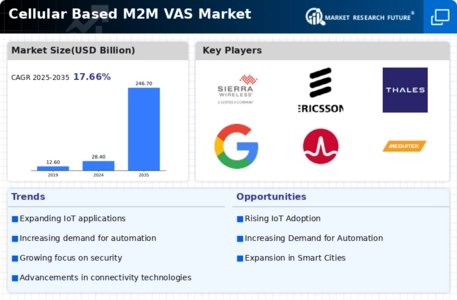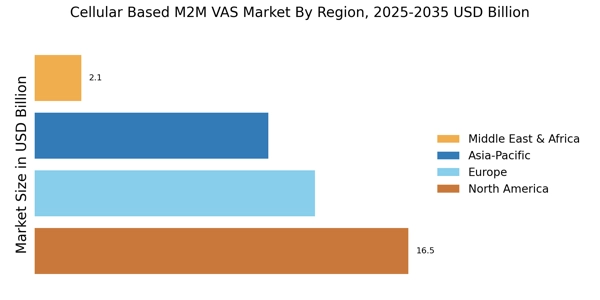Increased Adoption of IoT Devices
The proliferation of Internet of Things (IoT) devices is a primary driver for the Cellular Based M2M VAS Market. As organizations increasingly integrate IoT solutions into their operations, the demand for reliable and efficient communication networks intensifies. In 2025, it is estimated that the number of connected IoT devices will surpass 30 billion, necessitating robust cellular connectivity. This surge in device adoption compels service providers to enhance their offerings, thereby fostering growth in the Cellular Based M2M VAS Market. Furthermore, the integration of IoT with cellular networks facilitates real-time data transmission, which is crucial for applications such as smart metering, fleet management, and remote monitoring. Consequently, the synergy between IoT and cellular technology is likely to drive innovation and expand the market landscape.
Advancements in Cellular Technology
Technological advancements in cellular networks, particularly the rollout of 5G, are poised to significantly impact the Cellular Based M2M VAS Market. The enhanced speed, lower latency, and increased capacity of 5G networks enable more devices to connect simultaneously, which is essential for M2M applications. By 2025, it is projected that 5G will account for a substantial portion of cellular connections, facilitating the deployment of advanced applications such as autonomous vehicles and smart infrastructure. These advancements not only improve operational efficiency but also enhance user experiences, thereby attracting more businesses to adopt M2M solutions. As a result, the Cellular Based M2M VAS Market is likely to witness accelerated growth driven by the capabilities offered by next-generation cellular technologies.
Regulatory Support for M2M Solutions
Regulatory frameworks supporting the deployment of M2M solutions are emerging as a crucial driver for the Cellular Based M2M VAS Market. Governments are recognizing the potential of M2M technologies to enhance efficiency and promote innovation across various sectors. Initiatives aimed at fostering smart city developments and improving public safety are encouraging the adoption of M2M solutions. For instance, regulations that mandate the use of connected devices in transportation and energy sectors are likely to propel market growth. By 2025, it is anticipated that more countries will implement supportive policies, further legitimizing the use of M2M technologies. This regulatory backing not only enhances market confidence but also stimulates investment in the Cellular Based M2M VAS Market, paving the way for sustained growth.
Growing Need for Real-Time Data Analytics
The demand for real-time data analytics is increasingly shaping the Cellular Based M2M VAS Market. Organizations are recognizing the value of data-driven decision-making, which necessitates the collection and analysis of data from various sources. M2M solutions enable businesses to gather real-time data from connected devices, facilitating timely insights and operational improvements. In 2025, the market for real-time analytics is expected to reach significant valuations, underscoring the importance of M2M technologies in this context. The ability to monitor performance, predict maintenance needs, and optimize resource allocation through real-time data is becoming indispensable across sectors such as manufacturing, healthcare, and logistics. Thus, the Cellular Based M2M VAS Market is likely to expand as companies increasingly seek to leverage data analytics for competitive advantage.
Rising Demand for Remote Monitoring Solutions
The increasing need for remote monitoring solutions is driving growth in the Cellular Based M2M VAS Market. As businesses seek to enhance operational efficiency and reduce costs, remote monitoring technologies are becoming essential. Industries such as agriculture, healthcare, and manufacturing are leveraging M2M solutions to monitor equipment, track assets, and ensure compliance with safety standards. By 2025, the market for remote monitoring solutions is projected to experience substantial growth, reflecting the shift towards more automated and connected operations. The ability to monitor systems in real-time not only improves decision-making but also minimizes downtime and enhances productivity. Consequently, the Cellular Based M2M VAS Market is likely to benefit from this rising demand, as organizations increasingly adopt M2M technologies to facilitate remote monitoring.



















Leave a Comment